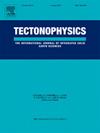Numerical modelling of lithosphere-asthenosphere interaction and intraplate deformation in the Gulf of Guinea
IF 2.7
3区 地球科学
Q2 GEOCHEMISTRY & GEOPHYSICS
引用次数: 0
Abstract
To present day, the phenomenon of intraplate deformation and its associated earthquakes remain elusive. In this work, we argue that intraplate deformation may result from the interaction between lithospheric and upper mantle dynamic processes. To this extent, we targeted the Gulf of Guinea and adjacent Western Africa, a region with both low plate velocities and clear asthenosphere dynamics, allowing us to isolate the individual underlying dynamic constraints which govern intraplate deformation. Thus, here we present 3D numerical geodynamic models of the asthenosphere-lithosphere interaction in the Gulf of Guinea, ran with the state-of-the-art modelling code LaMEM. We employ different initial/boundary conditions such as: (a) identical vs different spreading rates for the varying segments of the Atlantic mid-ocean ridge, (b) the presence/absence of weak zones (e.g., the Romanche/Central-African shear zones), and (c) the effect exerted by an active mantle plume, with a varying ascension velocity. Seismicity patterns was used to evaluate the models and their validity. Our results suggest that intraplate deformation within the Gulf of Guinea is influenced by the spreading rate of the mid-ocean ridge, with stress being localized around the ocean-continent transition and existing shear zones. They also suggest that the existence of an underlying stress source (e.g., a mantle plume) beneath the Cameroon region is crucial to explain the epicenter distribution/deformation in the region.
几内亚湾岩石圈-岩石圈相互作用和板块内变形的数值模拟
时至今日,板块内变形和与之相关的地震现象仍然难以捉摸。本文认为,板内变形可能是岩石圈和上地幔动力过程相互作用的结果。在这种程度上,我们的目标是几内亚湾和邻近的西非,这是一个板块速度低、软流圈动力学清晰的地区,使我们能够分离出控制板内变形的单个潜在动力约束。因此,在这里,我们提出了几内亚湾软流层-岩石圈相互作用的三维数值地球动力学模型,并使用了最先进的建模代码LaMEM。我们采用了不同的初始/边界条件,如:(a)大西洋中洋脊不同部分相同或不同的扩展速率,(b)弱带(如罗曼切/中非切变带)的存在/不存在,以及(c)活动地幔柱施加的影响,具有不同的上升速度。地震活动性模式被用来评价模型及其有效性。我们的研究结果表明,几内亚湾的板内变形受洋中脊扩张速度的影响,应力集中在洋陆过渡和现有剪切带周围。他们还认为,喀麦隆地区下方存在一个潜在的应力源(例如地幔柱),这对于解释该地区的震中分布/变形至关重要。
本文章由计算机程序翻译,如有差异,请以英文原文为准。
求助全文
约1分钟内获得全文
求助全文
来源期刊

Tectonophysics
地学-地球化学与地球物理
CiteScore
4.90
自引率
6.90%
发文量
300
审稿时长
6 months
期刊介绍:
The prime focus of Tectonophysics will be high-impact original research and reviews in the fields of kinematics, structure, composition, and dynamics of the solid arth at all scales. Tectonophysics particularly encourages submission of papers based on the integration of a multitude of geophysical, geological, geochemical, geodynamic, and geotectonic methods
 求助内容:
求助内容: 应助结果提醒方式:
应助结果提醒方式:


